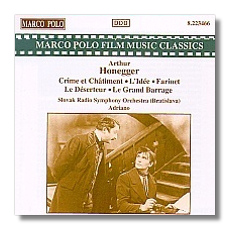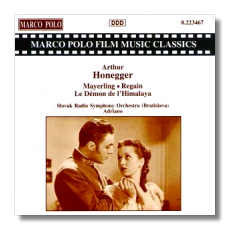
The Internet's Premier Classical Music Source
Related Links
- Honegger Reviews
- Latest Reviews
- More Reviews
-
By Composer
-
Collections
DVD & Blu-ray
Books
Concert Reviews
Articles/Interviews
Software
Audio
Search Amazon
Recommended Links
Site News
 CD Review
CD Review
Arthur Honegger

Film Music
- Farinet "L'or dans la montagne"
- Crime et Châtiment
- Le Déserteur
- Le Grande Barrage
- L'Idée
Slovak Radio Symphony Orchestra/Adriano
Marco Polo 8.223466 58:48


- Mayerling
- Regain
- Le Démon de l'Himalaya
Slovak Radio Symphony Orchestra/Adriano
Marco Polo 8.22346 759:51
Summary for the Busy Executive: Film music grows up.
Music has accompanied film since the early silents, but it took until roughly the Twenties before Modern composers got into the business in a big way. The United States, both Astoria and Hollywood, lagged behind, preferring, even well into the Thirties, ex-movie organists and theater-pit conductors to concert-hall composers. As in Germany with Hindemith and Weill, leading composers like Copland, Antheil, Thomson, and so on found themselves more or less relegated to the documentarians and the avant-garde. England and France did much better integrating classical composers with more or less commercial product.
Honegger certainly qualifies as one of the pioneers. His influence on French film composers was enormous, and he launched several careers, most notably that of Miklós Rózsa. Very early on, he got to work on great movies, beginning with Abel Gance's La Roue and Napoleon, the former as early as 1922. In rather sharp contrast to many movie scorers of the time, Honegger avoided both close musical imitation of the screen action and Wagnerian underscoring. One often can't tell the difference between Honegger's movie cues and his symphonic work. Honegger had a passion for definite, classical form. Furthermore, unlike many film composers, he thought of at least some of his movie music as symphonic and arranged his cues into symphonic suites. Indeed, it's quite remarkable, even in suites arranged by other hands from cues less than a minute long, how well Honegger's film music holds together. One must, however, distinguish between Honegger's film music and the pictures he worked on. French directors of the time thought little of setting several composers to work on a score. To many of the films, Honegger counted as one musical contributor of several.
I daresay that most United Statespersons haven't seen any of the movies Honegger worked on or would recognize directors' and actors' names. We're that parochial, and our historic memory is definitely short-term. Farinet, after a novel by Ramuz (librettist of Stravinsky's L'Histoire du soldat), is in its movie incarnation a typically French mix of cheap melodrama and philosophical speculations about freedom, and it boasts Barrault in the title role. Honegger contributed the main title, the finale, an "atmospheric" accompaniment to an intimate conversation, and pursuit music. The pursuit music interested me most by far – very contrapuntal and at the same time very clearly scored.
Honegger's music for Crime and Punishment reminds me a bit of the movie itself – okay, but not really up to the book. However, the composer does call for an ondes martinot (which he first used in L'Idée), sometimes to reinforce bass notes, but often to take solos, usually portraying Raskolnikov and Sonia. However, for those of us used to the Hollywood mega-orchestra on steroids approach, Honegger's ensemble will sound a bit thin. Honegger's arrived at his method of movie scoring by practical experience from the early days of sound, where the recording equipment couldn't capture orchestral depth and thus everything sounded cramped and muddy. He tends to avoid expanded percussion and even double basses and to include a piano at the expense of strings, all to the end of getting the music clean and clear. However, for the CD, the strings, in most cases, have been reinforced, so that instead of Honegger's rather original ideas, we get something much more conventional. I don't really understand this kind of silent editing, as if a composer like poor old Honegger needed orchestration help.
For Le Déserteur, Honegger supplied less than a third of the music. The fragment here is actually three different Honegger cues, woven together by someone other than the composer. The composer conveys intensity and obsession by canny use of rhythmic ostinato over which a wayward chromatic line wails.
Le Grande Barrage counts as something of a curiosity. No film by that name came out at the time Honegger wrote the fragment in the early Forties or, indeed, during Honegger's lifetime. Only the three-minute fragment recorded here survives, but it's a beaut – very complex and exciting, a kind of Pacific 231 in miniature.
I actually saw L'Idée, I think on WNET in New York. It's an odd little movie, a cartoon less than half an hour long. Created in 1932 (not 1934, as the liner notes claim), it animates woodcuts by Belgian artist Franz Masereel, although "animate" may be too strong a term. The animation consists mainly of cuts and dissolves between different woodcuts – a montage technique, if I recall right. The "story" is humanity's attempt to follow an ideal throughout its history. The woodcuts remind one very strongly of German Expressionism and UFA set design, particularly for Lang's Metropolis as well as for The Cabinet of Dr. Caligari. The "philosophy" (as fans of The Matrix like to say) doesn't mean as much (or much at all) as the progression of images, but the images exude great power. For me, this is a classic movie, very little known. Honegger Germanized his idiom somewhat. Lean and acidic, the music evokes a Kurt-Weill cabaret band. Even with Adriano's increase of strings over the original string quartet, this performance keeps much of that flavor. The music is continuous and gives us a chance to hear more clearly Honegger's feel for real symphonic movement in something ordinarily fragmented.
Anatole Litvak's Mayerling has nothing on Ophüls's treatment of the same subject, but it does work better than the horrid version of the Seventies. Among other things, it lets us glimpse Charles Boyer in a somewhat different context than his American career. He was a really good actor in either case, but far more complex with a bit more gravitas when he acted in his own language. Honegger invests the double suicide of the Archduke and his mistress with both irony at the frivolity of their lives and with pathos toward their deaths. It foreshadows the music of the fifth symphony. The finale of the suite (published in 1936) builds to two climactic pistol shots.
I suppose very few people recognize the name of Marcel Pagnol, a writer and movie director inspired by the laborers of the south of France. The film stars the rubber-faced Fernandel, who can break you up with a goofy grin. Honegger's score for Regain is one of his best, although in its film incarnation it was manhandled, snipped, and removed with no regard for the composer's input. Perhaps out of self-defense, Honegger arranged some of the cues into one suite. I assume Adriano assembled the second suite also recorded here. Unlike some of his scores, Regain shows off Honegger's ability to cover a wide range of emotions. For example, the cue "Printemps" brims full of Honegger's "nature mood," probably best known from the Pastorale d'eté. On the other hand, "Gédémus le rémouler" reveals Honegger's comic gift, similar to Prokofieff's, all too seldom encountered in his concert work.
Le Démon de l'Himalaya is an odd picture. A documentary filmmaker into mountain climbing had some footage left over and decided to make a thriller, very similar to the plot of The Mummy by the way. I haven't seen this film, but it does sound terrible. Some of the footage the producer sold to Columbia for use in Capra's Lost Horizons. Perhaps the images save it. At any rate, the producer liked it enough to remake it in early Fifties Hollywood as Storm over Tibet. Adriano considers this one of Honegger's most important film scores, and you see his point. It anticipates by several years Herrmann's hypnotic use of ostinato and repetitive single-chord shifts. The musical idiom is far beyond just about everyone at the time (except for avant-garde film composers like Thomson and Shostakovich) – very chromatic and tonally nebulous. The orchestration is also at the edge, and it includes the ondes martinot Significantly, I think, one hears this music in essentially a horror movie. The "Snowstorm" cue certainly scared the jeepers out of me. Audiences probably accepted it – just as they accepted Waxman's forward-looking score to Bride of Frankenstein – because it increased the delicious thrill of movie fright. Real fright, of course, is far more intense, overwhelming, incomprehensible, and curiously distancing.
Adriano is a fine musician, even though the one-name bit strikes me as hokey as Liberace. Rhythm isn't quite as sharp as I like it, but he certainly keeps his forces together and the music moving. He's especially good over the long haul, with the scores for L'Idée and Le Démon (two large excerpts from the latter, amounting to twenty minutes of music). Especially in the "Snowstorm" cue, where the repetitive nature of the music could grind everybody to a halt, Adriano manages to build, fall back, and build again. He has a superb feel for how music "goes." Marco Polo does a good job with the recorded sound, although it might hit some as a bit too bright.
Copyright © 2003, Steve Schwartz



















